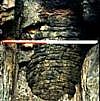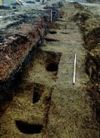|
|||||
| <Click on a picture to see it larger> | |||||
 The site during development  The well  Some of the features uncovered |
The Local Planning Authority's Archaeology Advisor advised that an archaeological watching brief was to be carried out during the proposed development. Marches Archaeology was commissioned by Building Design Group, agents for the developer, to provide the archaeological services required. The site lies within the historic core of Mansfield to the north of the market place. The properties which had originally occupied the site were recently destroyed by fire and then levelled to create a car park. Industrial activity on the site predating the late Victorian development of the area was seen immediately behind the present line of Clumber Street. Several shallow stone-lined wells and a culvert cut natural clay deposits. The culvert was still functional and had been incorporated by the Water Board into the road drainage below the demolition rubble. The culvert probably dates to the first attempt to establish a water supply for the town in 1870. Two small rectangular chambers were recorded to the north of the culvert, one was filled with ash and iron slag and another with standing water. They were probably the remains of a furnace and cistern respectively. They were linked to sandstone walls and appear to represent a substantial building demolished before the late Victorian redevelopment of the area. This building could have been on the site of 'Hyve Yard' recorded on J. Bradbury's historical map of Tudor Mansfield. Pottery recovered from a stone lined drain in front of a blocked doorway in the main wall of the building was spot dated to the late 17th or early 18th century. A well and cistern with adjacent dumps of furnace waste was also uncovered below Clumber Street and backfilled with modern debris including fragments of pavement and tarmac. The earliest layer may have been a lane or yard surface. Pottery recovered from the surface was 19th century but pottery recovered from the backfill of an adjacent building was 18th century. The documentary evidence shows that until the beginning of the 17th century the medieval field system had remained relatively intact to the north of the town. The watching brief revealed the western wall of a massive stone building which was dated architecturally to the 17th century. An upstanding section of this wall could be seen to have door and window openings constructed by using vertical stone pillars, capped with a stone lintel. This style of building is indicative of many of the earlier stone buildings within the town. By the 19th century an elongated yard or lane ran along the outside of the building and brick additions had been made to create a cellar. After the catastrophic destruction of the town by several fires during the 16th century the industrial area of the town expanded to the north of West Gate. The slag evidence indicated that the first industrial structures on the site may have been small scale metalworking workshops in the 18th century, and as this process changed to larger scale production, buildings were rebuilt internally and extended during the 19th century. The earliest archaeological features found on site were stakeholes and postholes and two roughly linear but shallow features. The postholes were cut into subsoil. Above these features the cultivation horizon produced early 19th century pottery and a single residual medieval sherd. However, the most frequently recovered pottery types from this cultivation horizon were from the 18th century. The small quantity of animal bone and pottery recovered from this context suggests cultivation rather than dumping. The residual nature of the pottery suggests long term use while two linear features found at the base of the cultivation soil indicated a relict medieval ridge and furrow. |
||||
<<click here to go back to watching brief services>> |
|||||
<<click here to go back to list of archived projects>> |
|||||
